Lexical resources
Estonian dictionaries
 The Dictionary of Standard Estonian ÕS 2013 (2013)
The Dictionary of Standard Estonian ÕS 2013 (2013) ![]()
ÕS 2013 is a normative dictionary of modern standard Estonian, giving recommendations on correct language use. It contains recommended spellings and the morphology of words, instructions on pronunciation and semantics, also some syntactic recommendations. Abbreviations, geographical names and instruction on pronouncing foreign names are attached.
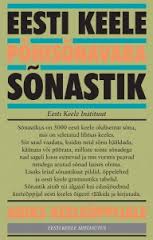 The Basic Estonian Dictionary (2014)
The Basic Estonian Dictionary (2014) ![]()
The dictionary includes 5000 important Estonian words explained in a simple language. There are also some auxiliary materials to help you. Picture pages show clothing, fruits, vegetables, vehicles, animals, etc. Study pages introduce Estonian punctuation and how to write numbers, dates, time, etc. Countries and peoples is a table presenting a selection of countries with the names of major inhabiting peoples and of the languages they speak. Grammar tables help you with word conjugation and declination as well as with degrees of comparison. In addition it is shown how most of the whole inflectional paradigm can be produced knowing just a few forms. For teacher offers ideas on what kind of exercises can be made in order to develop students’ linguistic and lexicographic competence.
 The Explanatory Dictionary of Estonian (2009)
The Explanatory Dictionary of Estonian (2009) ![]()
The biggest dictionary of the Estonian language, which covers Estonian standard language as a whole, including spoken language and special languages.
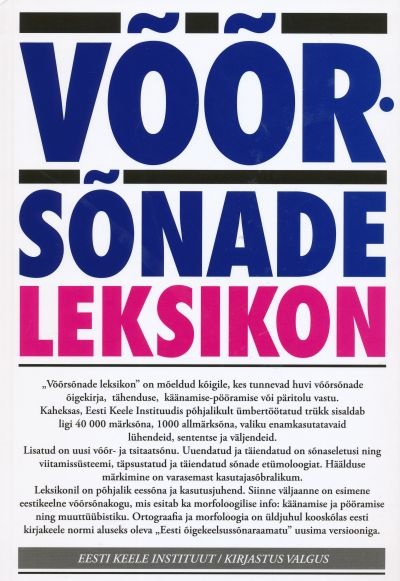 The Dictionary of Foreign Words (2012)
The Dictionary of Foreign Words (2012) ![]()
The lexicon contains 33,000 widespread words of plainly foreign origin, including citations, incompletely adapted loanwords, abbreviations, maxims and expressions. The lexicon provides information on the orthography, inflection, semantics and etymology of the words; for many unadapted foreign words the pronunciation is given, both audio and written; the understanding and use of the words is facilitated by labels and cross-references.
![]() The Advisory Dictionary of Document Language (2013)
The Advisory Dictionary of Document Language (2013) ![]()
A good helper for anyone who needs to write an official Estonian text. There are a lot of tips and recommendations for simple, plain and precise expression.
![]() The Estonian Etymological Dictionary (2012)
The Estonian Etymological Dictionary (2012) ![]()
Contains information on the origin of Estonian word stems and the genetic links between words (loanwords, genuine stems, artificially coined stems etc).
![]() The Dictionary of Estonian Synonyms (1991)
The Dictionary of Estonian Synonyms (1991) ![]()
This is a comprehensive dictionary of Estonian synonyms, offering words used in writing and/or speech, including a selection of older, dialectal and colloquial words or expressions, plus some special terms as well as red-tape and stereotyped expressions.
![]() The Dictionary of Estonian Antonyms (1995)
The Dictionary of Estonian Antonyms (1995) ![]()
The dictionary contains nearly 2000 antonym pairs most of which belong to general language. Each entry word is presented together with its antonym (e.g., suur : väike ´big : small´ or vabastama : vangistama ´set free : arrest´).
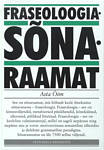 The Dictionary of Estonian Phraseology (2000)
The Dictionary of Estonian Phraseology (2000) ![]()
Contains over 7,500 phrasemes, including bookish, colloquial, obsolete and vulgar expressions, as well as various sayings and also some red-tape and stereotyped expressions.
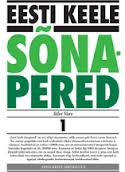 The Dictionary of Estonian Word Families (2012)
The Dictionary of Estonian Word Families (2012) ![]()
The first Estonian dictionary of word families; it provides a comprehensive view of the riches of Estonian word formation, describing the structure and formative relations of ca 120,000 Estonian words. Based of the formative relations, the words make up nearly 9000 word families. A word family consists of all the words that are linked by formative processes and share one and the same word stem.
 The Dictionary of Estonian Word Families – Index (2012)
The Dictionary of Estonian Word Families – Index (2012) ![]()
xx
![]() Estonian Frequency Dictionary (2002)
Estonian Frequency Dictionary (2002) ![]()
The dictionary is based on 1 million word corpus that includes fiction and journalistic texts.
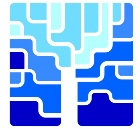 Low Germanic Loanwords in Estonian (2016)
Low Germanic Loanwords in Estonian (2016) ![]()
This is an online dictionary of Low-German loanwords, most of which persist in Estonian ever since the 13th–17th centuries. There are 1,150 words from standard Estonian and from Estonian dialects.
Estonian Dialect Dictionaries
![]() The Dictionary of the Eastern Dialect (2016)
The Dictionary of the Eastern Dialect (2016) ![]()
This dictionary of 7000 entry words is intended for everyone who deals with dialects, either professionally or academically, as well as for the people with an Eastern-Estonian background who find their ancestors´ tongue fascinating.
![]() The Dictionary of the Hiiu Dialect (2015)
The Dictionary of the Hiiu Dialect (2015) ![]()
This is the first ever dictionary of the Hiiu vernacular. Its 6300 entry words include the core vocabulary as well as dialect words from every subdialect spoken on the island of Hiiumaa. As the specifics of the Hiiu tongue are mainly manifested in its phonetics the dictionary provides the vernacular pronunciation of common words as well. The entries also give sentence examples with reference to their source parish.
![]() The Dictionary of the Kihnu Dialect (2016)
The Dictionary of the Kihnu Dialect (2016) ![]()
The dictionary presents lexical material from the vernacular actively spoken on the islands of Kihnu and Manija. Apart from the 6000 dialect words there is a selection of personal and place names. The entry list contains quite ancient words as well as some that have arrived in the Kihnu vernacular only in the recent decades. The basic forms and sentence examples (with translations into standard Estonian) facilitate learning and use of the dialect.
![]() The Dictionary of the Seto Dialect (2016)
The Dictionary of the Seto Dialect (2016) ![]()
The first online Seto dictionary contains over 6000 keywords accessible to search both in dialect orthography and in simplified spelling (without diacritical marks).
![]() The Dictionary of the Mulgi Dialect (2016)
The Dictionary of the Mulgi Dialect (2016) ![]()
An online dictionary searchable by keyword (in dialect spelling), standard Estonian equivalent (meaning) or style label. Most of the entry words are provided with sentence examples and references to words with the same or similar meaning.
![]() The Dialectological Dictionary of Estonian (1982-1989)
The Dialectological Dictionary of Estonian (1982-1989) ![]()
Provides a survey of Estonian dialect vords and their areal distribution.
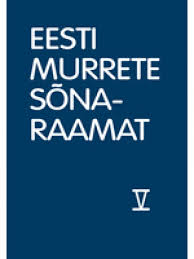 The Dictionary of Estonian Dialects (2013–...; lõpetis-nisu)
The Dictionary of Estonian Dialects (2013–...; lõpetis-nisu) ![]()
The aim of this dictionary is to possibly cover the whole vocabulary of Estonian dialects. The entry words are accompanied by phonetic and grammatical data, their area of distribution, and meaning. Sentence examples demonstrate additional grammatical and semantic specifics of the words.
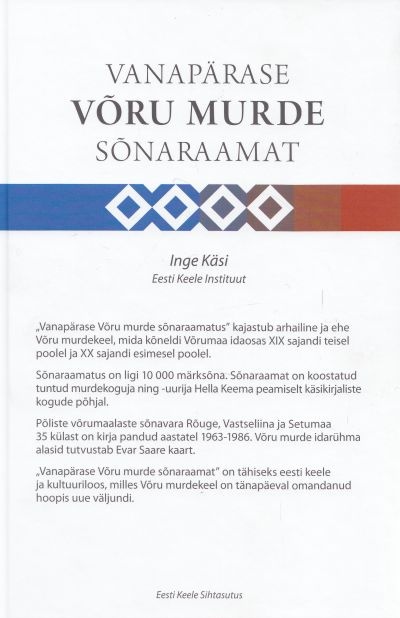 The Dictionary of Old Võru Dialect (2011)
The Dictionary of Old Võru Dialect (2011) 
The dictionary reveals the archaic Võru dialect, that was spoken in the eastern part of Võru county in the second half of the 19th and in the first half of the 20th century. The dictionary contains approximately 10,000 entries with usage examples. The dictionary has been compiled mainly on the basis of manuscript collections, compiled by Hella Keem, a dialect collector and linguist specialist in the Võru dialect. Everyday language spoken by the indigenous Võru people from Rõuge, Vastseliina, and Setomaa parishes has been noted down in the period 1963–1986.
Bilingual Dictionaries
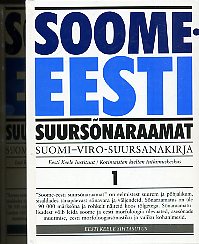 Finnish-Estonian Dictionary (2017) NEW!
Finnish-Estonian Dictionary (2017) NEW!
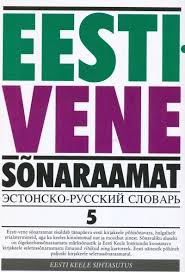 The Estonian-Russian Dictionary (1997-2009)
The Estonian-Russian Dictionary (1997-2009) 
The biggest and most comprehensive Estonian-Russian dictionary.
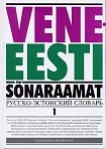 The Russian-Estonian Dictionary (2000)
The Russian-Estonian Dictionary (2000) 
The entry list of the dictionary contains ca 74,000 words. Most of the entries include a number of typical word combinations for the entry word, which illustrate its semantic nuances and present the user with the most widespread uses of the word in a ready-made form.
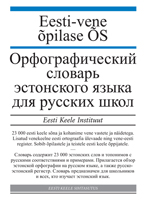 The Estonian-Russian Leaner`s Orthographic Dictionary (2011)
The Estonian-Russian Leaner`s Orthographic Dictionary (2011) 
The Estonian-Russian Learner´s ÕS is mainly meant for those learners of Estonian whose mother tongue is Russian or who learn it through Russian. Words can be searched via Estonian as well as via Russian. The dictionary is a combination of the Dictionary of Standard Estonian, A Learner´s Dictionary of Standard Estonian, and The Estonian-Russian Dictionary. It contains 23,000 Estonian words and place names with Russian equivalents and examples. There is also a Russian-language survey of Estonian orthography and a Russian-Estonian index.
![]() The English-Estonian Machine Translation Dictionary (constantly updated)
The English-Estonian Machine Translation Dictionary (constantly updated) 
A constantly incremented English-Estonian online dictionary, which is helpful in both human and machine translation. Currently, there are nearly 90,000 English words and phrases. Being created as a hobby, the dictionary need not meet all the quality standards of the Institute of the Estonian Language.
![]() The Estonian-Norwegian Dictionary (1998)
The Estonian-Norwegian Dictionary (1998) 
Contains ca 19,000 Estonian and 21,000 Norwegian entry words with grammatical data and numerous usage examples.
![]() The Norwegian-Estonian Dictionary (1998)
The Norwegian-Estonian Dictionary (1998) 
Contains ca 19,000 Estonian and 21,000 Norwegian entry words with grammatical data and numerous usage examples.
![]() The Estonian-Latvian Dictionary (2015)
The Estonian-Latvian Dictionary (2015) 
A two-way Estonian–Latvian dictionary of nearly 47,000 entries.
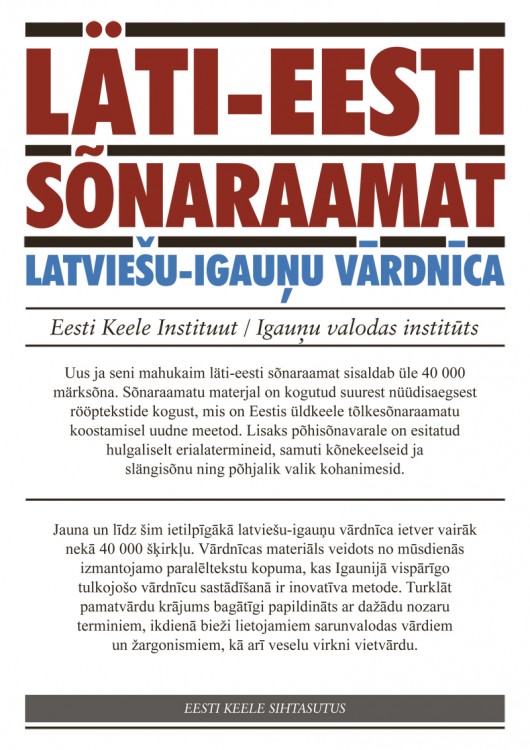 The Latvian-Estonian Dictionary (2015)
The Latvian-Estonian Dictionary (2015) 
A two-way Latvian-Estonian dictionary of nearly 47,000 entries.
![]() The Estonian-Udmurt Dictionary (2015)
The Estonian-Udmurt Dictionary (2015) ![]()
The first ever Estonian-Udmurt dictionary. It contains ca 10,000 entry words and is innovation-oriented; namely, in absence of an Udmurt equivalent, the authors suggest one of their own invention. Also, there are remarkably many words from Udmurt dialects.
 Estonian-Mari Dictionary (2017)
Estonian-Mari Dictionary (2017) ![]()
Contains ca 9,800 entries.
![]() The Livonian-German Dictionary (1861)
The Livonian-German Dictionary (1861) ![]()
An online Livonian–German version of the dictionary by Sjögren and Wiedemann.
![]() The Online Dictionary of the Estonian Sign Language – Estonian (2014)
The Online Dictionary of the Estonian Sign Language – Estonian (2014) ![]()
The dictionary contains over 4000 entry words, enabling search either by an Estonian word or a by a sign of Estonian sign language. The target users are learners of Estonian sign language and the users of Estonian sign language who study Estonian.
Multilingual Dictionaries
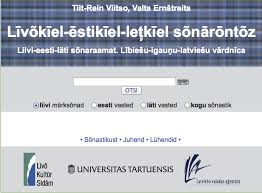 Livonian-Estonian-Latvian Dictionary (2012)
Livonian-Estonian-Latvian Dictionary (2012)
Place Names Data
![]() Dictionary of Estonian Place Names (2016)
Dictionary of Estonian Place Names (2016) ![]() NEW!
NEW!
Etymological dictionary containing all official village names of Estonia and selected group of other Estonian place names.
![]() The Place Names Database of the Institute of the Estonian Language (KNAB) (constantly updated)
The Place Names Database of the Institute of the Estonian Language (KNAB) (constantly updated) ![]()
Place names from Estonia and the world over.
The list is based on the Estonian orthography of foreign place names (including tne names of countries) agreed upon by the Language Committee at the Mother Tongue Society in 1996 and published in a special supplement of the Language Planning Dictionary. Ever since, the list has been constantly monitored and updated. The list is harmonised with the ISO 3166-1 standard.
Declension of Estonian family names
![]() The Family Name Database of the Institute of the Estonian Language
The Family Name Database of the Institute of the Estonian Language ![]()
The Family Name Database gives information on how to decline Estonian family names. Besides the nominative form, each name is provided with its shapes in the genitive, partitive and allative cases. If a name fits more than one paradigm, all options are included.
Term Dictionaries
![]() The English-Estonian Maritime Dictionary (2008)
The English-Estonian Maritime Dictionary (2008) ![]()
Over 30,000 entry words. Apart from common nautical terms there are terms concerning sailing ships, wooden boats, sea trade, maritime law, marine insurance, container transport, fishery, navy, radiolocation, hydromechanics, oceanography, sailing etc.
![]() The Dictionary of Education (2013)
The Dictionary of Education (2013) ![]()
Contains 4850 special terms from several fields, such as education, didactics, pre-school (kindergarten) education, basic and secondary education, vocational and higher education, andragogy, and special education. Every term is provided with an equivalent in English, German, Finnish and Russian; in most cases, an Estonian explanation is added.
 The Dictionary of Extracurricular Activities (working draft)
The Dictionary of Extracurricular Activities (working draft) ![]()
Contains special terms from the field of extracurricular activities and interests provided with Estonian explanations and English, German, Finnish and Russian equivalents.
ESTERM is a multilingual translation-based termbase; the terms come from the legal acts of the Republic of Estonia and the European Union, translated by the Estonian Legal Language Centre.
MILITERM is a database of military, security and defense terms, enabling search by Estonian, English, French and German keywords. The Estonian and English special terms are provided with definitions.
Queries over many language resources
![]() Estonian Multiple Dictionary and Corpora Query Keeleveeb
Estonian Multiple Dictionary and Corpora Query Keeleveeb
The idea behind Keeleveeb is to carry out a query over many language resources — dictionaries and corpora. Estonian is a morphologically rich language, and to find a word in corpus text is not a trivial task. Most probably the word that you are interested in, is in some inflected form, that is not the dictionary keyword form (singular nominative for nouns and supine for verbs). Because of that the morphological analyzer and synthesizer are integrated into the system as well.
![]() The Combined Dictionary Search and Language Helpline (e-keelenõu)
The Combined Dictionary Search and Language Helpline (e-keelenõu) ![]()
A fine opportunity to respond to a query by retrieving information from several sources. Simple, time-saving and possibly addressing some sources the user need not even have considered.
Dictionary Writing Systems
 The Online Writing System EELex
The Online Writing System EELex ![]()
The lexicographer´s workbench EELex is a web-based set of tools to interface the software and language resources necessary for dictionary editors and compilers, supporting group work and the Estonian language. EELex software is a dictionary management system enabling the lexicographer to compile, edit, and lay out dictionaries, make simple as well as complex structural queries and sort the responses. Editing is also facilitated by several tools, such as cross-reference check, multiple corrections throughout the dictionary, automatic generation of the block of Estonian morphology, layout view, export to Word etc.
 Terminology Management Software Termeki
Terminology Management Software Termeki ![]()
Software for terminology management offered by the Institute of the Estonian Language free of charge.
Other
 Handbook of the Estonian language (2007)
Handbook of the Estonian language (2007) ![]()
![]() The First Estonian Slang Dictionary (1990)
The First Estonian Slang Dictionary (1990) ![]()
The slang words for the dictionary were collected from Estonian-language high schools of Tallinn in the spring of 1989. The dictionary is thematically structured; the slang words are explained under ca 150 themes.
- Estonian-French Dictionary (GDEF) (compiling)


